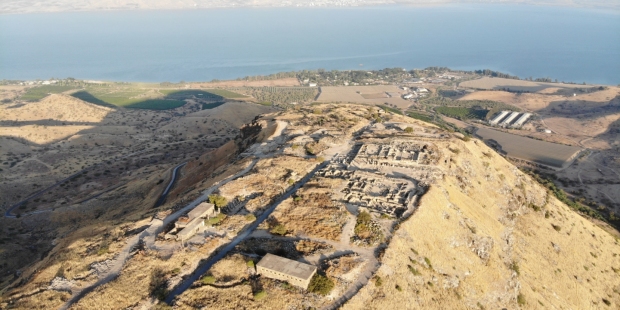A newly excavated archaeological site that has been developed into a national park in Northern Israel is opening just in time for the Passover holiday, and even more appropriately, the upcoming Chiristan holiday of Easter. The site, which dates back to the time of the Maccabees, is rich with early Christian and subsequent Byzantinian structures and has direct connection to the Gospels.
Sussita National Park, located on a hill off the slopes of the Golan Heights, east of the Sea of Galilee and in front of Kibbutz Ein Gev, is the site that preserves the magnificent remains of the ancient city of Hippos. The word 'ippos' means 'horse' in Greek while in Hebrew, the place is called 'Sussita', from the word 'soos' which translates as well into horse. The ancient city, whose name suggests a connection to horses, developed during the Hellenistic period starting from about 250 BC and reached its peak during the Roman and Byzantine periods and continued to exist, even thriving after the early part of the Muslim conquest until it was destroyed by a massive earthquake in 749 AD.
The site where the mask of Pan was found is the Hippos-Sussita National Park which is adjacent to the much-disputed Golan Heights. "Hippos-Sussita National Park" is not available on Google Maps, so I cannot measure the distance from it to the Golan Heights. pic.twitter.com/YjYpO4YLSu
— Julianne ✝️ (@KindeandTrue) July 1, 2020
Over the last 20 years, archeological excavations were conducted at the site by the Haifa University excavation team, initially led by Professor Arthur Segal and then Dr. Michael Eisenberg and Dr. Arlata Kovalevska. During this time, conservation efforts and development of infrastructure were carried out simultaneously with the excavations following a plan prepared by the Israeli Nature and Parks Authority with the purpose of preparing the site for public visits.
Visitors to the new National Park will be able to experience and be impressed by a variety of particularly impressive archaeological findings from the Roman and Byzantine periods, including the forum, which resembels an amphitheater, the central city square which is found in most European Christian cities, a huge water reservoir in the center of the forum, remains of a magnificent basilica and the 'odeon', a small indoor theater.
They happen to Sinners, true believers in the Truth!
— Mike (@SunDominus) February 6, 2021
"The colorful mosaic was uncovered at the Sussita National Park’s South-West or Burnt Church
The 15-meter mosaic carpet is bursting with fish, birds and 12 baskets filled with fruit, flowers and — arguably — bread..." pic.twitter.com/1ju6LS8sMp
In addition, there are also remains of eight churches, the largest of which is a cathedral adjacent to the Baptistery, a building intended for the rites of baptism into Christianity. In the cathedral, there is evidence of the great earthquake that destroyed the city in 749 AD.
Another layer on the site tells the fascinating story of the occupation of Sussita by members of Kibbutz Ein Gav during the Israeli War of Independence and the subsequent holding of the place by soldiers from the Israel Defense Forces disguised as policemen, who defended the place against the Syrian army until the Six Day War.
In this context, one can experience and be impressed by the various defense positions and bunkers that existed on this ancient site. There are also the remains of a cable car constructed by the early Israelis that allowed for the transfer of supplies to the soldiers on top of the mountain, and of course spectacular views of the entire area and especially of the Sea of Galilee.
The Minister of Heritage, Rabbi Amichai Eliyahu said in a statement: "The Ministry of Heritage is here for the benefit of the citizens of Israel and is proud to be part of the Sussita National Park upgrade and development project. The spectacular national garden overlooking the Sea of Galilee tells many stories in the history of our nation, from the days of the Second Temple to the War of Independence. I invite all the people of Israel to travel and visit the heritage sites throughout the country and experience the history and heritage of this wonderful nation directly. I wish everyone a happy and kosher Passover.
Netanyahu gets out to tour North: Prime Minister tours Sussita National Park with wife Sarah, calls on… https://t.co/QDvG8zdr8i ArutzSheva pic.twitter.com/oJf50zcB6d
— Jewish Community (@JComm_NewsFeeds) August 15, 2017
According to Raya Shurki, CEO of the Nature and Parks Authority, "We are honored and excited to open a new national park for the Israeli visitors, which will also become a significant focal point for tourists from all over the world and thus greatly support local tourism. Its opening is possible thanks to extensive conservation and development work led by the Nature and Parks Authority in cooperation with other entities with an investment of approximately 30 million NIS.”


